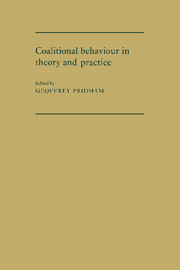Book contents
- Frontmatter
- Contents
- List of illustrations
- List of tables
- Notes on the contributors
- Preface
- 1 An inductive theoretical framework for coalitional behaviour: political parties in multi-dimensional perspective in Western Europe
- 2 Between theoretical elegance and political reality: deductive models and cabinet coalitions in Europe
- 3 Changing coalitional preferences among West German parties
- 4 The FDP and coalitional behaviour in the Federal Republic of Germany: multi-dimensional perspectives on the role of a pivotal party
- 5 Cabinet stability in the French Fourth Republic: the Ramadier coalition government of 1947
- 6 Coalition formation and maintenance in Belgium: a case-study of elite behaviour and changing cleavage structure, 1965–1981
- 7 The Dutch Christian Democratic party and coalitional behaviour in the Netherlands: a pivotal party in the face of depillarisation
- 8 Coalition or Fianna Fail? The politics of inter-party government in Ireland
- 9 Italy's party democracy and coalitional behaviour: a case-study in multi-dimensionality
- 10 Party coalitions in the first democratic period in Spain, 1977–1982
- 11 Coalitional theory and practice in Scandinavia
- 12 Multi-dimensional approaches to the study of local coalitions: some cross-national comparisons
- 13 Research notes
- Index
8 - Coalition or Fianna Fail? The politics of inter-party government in Ireland
Published online by Cambridge University Press: 05 November 2011
- Frontmatter
- Contents
- List of illustrations
- List of tables
- Notes on the contributors
- Preface
- 1 An inductive theoretical framework for coalitional behaviour: political parties in multi-dimensional perspective in Western Europe
- 2 Between theoretical elegance and political reality: deductive models and cabinet coalitions in Europe
- 3 Changing coalitional preferences among West German parties
- 4 The FDP and coalitional behaviour in the Federal Republic of Germany: multi-dimensional perspectives on the role of a pivotal party
- 5 Cabinet stability in the French Fourth Republic: the Ramadier coalition government of 1947
- 6 Coalition formation and maintenance in Belgium: a case-study of elite behaviour and changing cleavage structure, 1965–1981
- 7 The Dutch Christian Democratic party and coalitional behaviour in the Netherlands: a pivotal party in the face of depillarisation
- 8 Coalition or Fianna Fail? The politics of inter-party government in Ireland
- 9 Italy's party democracy and coalitional behaviour: a case-study in multi-dimensionality
- 10 Party coalitions in the first democratic period in Spain, 1977–1982
- 11 Coalitional theory and practice in Scandinavia
- 12 Multi-dimensional approaches to the study of local coalitions: some cross-national comparisons
- 13 Research notes
- Index
Summary
Introduction
Each of the five coalitions that have formed in the history of the Irish state has been the only alternative to a single-party (Fianna Fail) government. There can be no doubt that this is the single most salient feature of the politics of coalition in Ireland. In the first place it means that Ireland is a member, with Norway and Sweden, of that small group of countries in which coalitions and single-party governments tend to alternate in office. In the second place, it is an idiosyncratic member even of this exclusive club. Fianna Fail, the institution of single-party government, is a populist party of the centre-right, and has always refused to share power with anyone. This means that the coalitions that must form to replace it in office, unlike those in Norway and Sweden, have always needed to span the entire ideological range of Irish politics. While the ideological range of mainstream Irish politics is much narrower than that to be found in most European democracies, this nevertheless means that coalition members have been forced either to put up with or to forget considerable policy differences if they wanted to remain in power.
The normal processes of coalition bargaining are severely constrained in Ireland. Bargaining power in coalition negotiations is usually denominated, ultimately, in threats to bring down the government. Such threats depend upon the existence of viable alternative coalitions.
- Type
- Chapter
- Information
- Coalitional Behaviour in Theory and PracticeAn Inductive Model for Western Europe, pp. 171 - 197Publisher: Cambridge University PressPrint publication year: 1986

